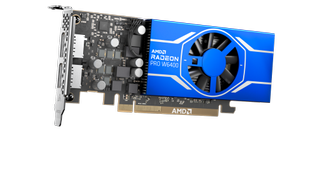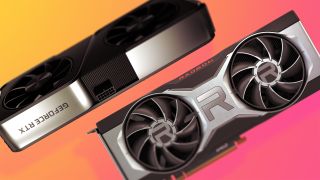AMD announces the Radeon Pro W6400 workstation graphics card
Very much entry level, though there are highlights.

AMD has released the entry level Radeon Pro W6400 workstation graphics card. AMD is targeting workstation users that don’t need the grunt of the faster and more expensive W6600 or W6800 cards.
The W6400 contains the 6nm RDNA2 Navi 24 GPU with 768 cores and it comes with 4GB GDDR6 RAM, two DisplayPort connectors and delivers up to 3.5 TFLOPs of FP32 and 7.0 TFLOPs of FP16 perfromance. These are not stellar numbers but there are highlights, as the card features a TDP of just 50W meaning it doesn’t require an external power connector. It’s also a low-profile single slot card, which means it's easy to install into even the most basic of OEM machines.

How to buy a graphics card: tips on buying a graphics card in the barren silicon landscape that is 2021
While the W6400 does have its upsides, it’s likely it will be hampered by some of its weak specifications, much like the underwhelming Navi 24 equipped Radeon RX 6500 XT is. Its PCIe x4 connection can hurt performance, and given that this card is likely to find its way into many PCIe 3.0 machines, it gives a bad impression. We’d also like to see a third display output. In fairness, the low profile design means it's not possible to fit a third display port, though a mini DP should have fit.
AMD believes the card is well positioned to compete with Nvidia’s comparative offerings, with more TFLOPS compared to Nvidia’s more expensive T1000 and T600 cards. AMD claims the card outperforms the T600 in CAD and image editing workloads and office applications including spreadsheet, web browsing and video conferencing tasks.
The W6400 won’t lead to gamers lining up to buy them, but with its low profile, low power design and workplace optimization, it will find worksation buyers.
The biggest gaming news, reviews and hardware deals
Keep up to date with the most important stories and the best deals, as picked by the PC Gamer team.

Chris' gaming experiences go back to the mid-nineties when he conned his parents into buying an 'educational PC' that was conveniently overpowered to play Doom and Tie Fighter. He developed a love of extreme overclocking that destroyed his savings despite the cheaper hardware on offer via his job at a PC store. To afford more LN2 he began moonlighting as a reviewer for VR-Zone before jumping the fence to work for MSI Australia. Since then, he's gone back to journalism, enthusiastically reviewing the latest and greatest components for PC & Tech Authority, PC Powerplay and currently Australian Personal Computer magazine and PC Gamer. Chris still puts far too many hours into Borderlands 3, always striving to become a more efficient killer.
Most Popular





